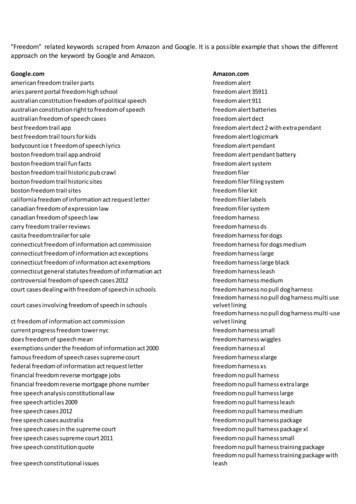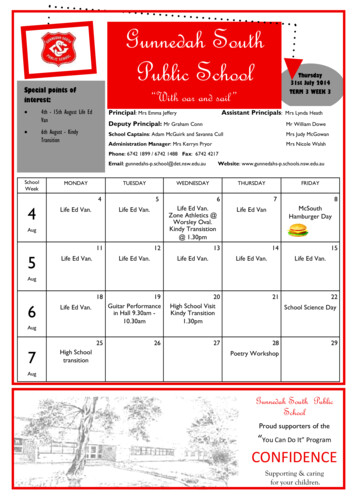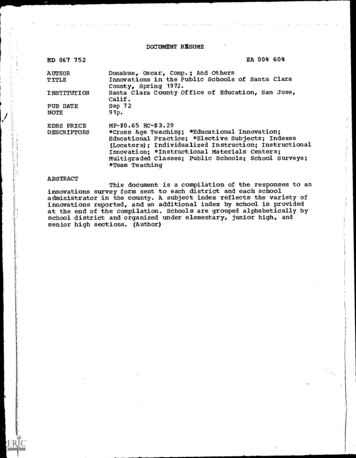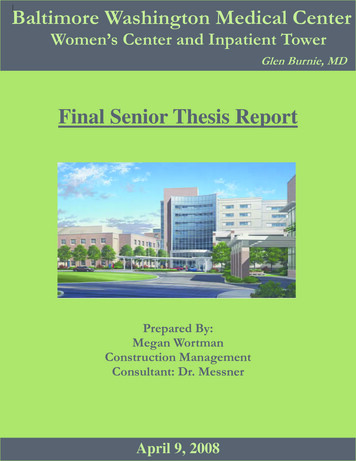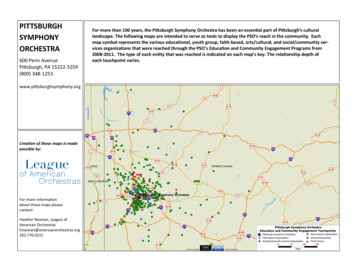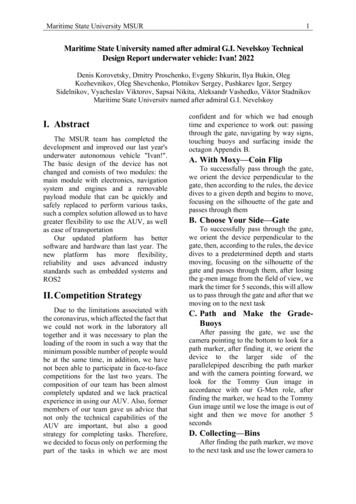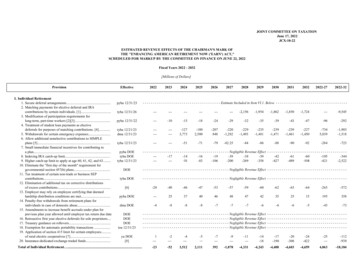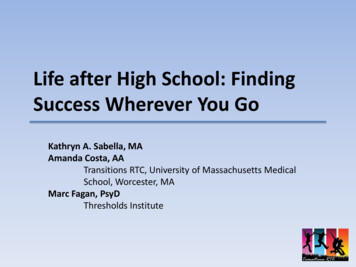
Transcription
Life after High School: FindingSuccess Wherever You GoKathryn A. Sabella, MAAmanda Costa, AATransitions RTC, University of Massachusetts MedicalSchool, Worcester, MAMarc Fagan, PsyDThresholds Institute
Transitions RTCThe Transitions RTC aims to:Improve supports for the successful completion ofschooling and movement into rewarding work livesamong young people, ages 14-30, with serious mentalhealth conditionsWhat we do: Conduct cutting-edge rigorous research that tests orinforms interventions Develop and translate knowledge to itionsRTC
AcknowledgementsThe Transitions RTC aims to improve the supports for youth and young adults,ages 14-30, with serious mental health conditions who are trying to successfullycomplete their schooling and training and move into rewarding work lives. Weare located at the University of Massachusetts Medical School, Worcester, MA,Department of Psychiatry, Center for Mental Health Services Research.Visit us tmThe contents of this presentation were developed with funding from the US Department ofEducation, National Institute on Disability and Rehabilitation Research, and the Center forMental Health Services, Substance Abuse and Mental Health Services Administration (NIDRRgrant H133B090018). Additional funding provided by UMass Medical School’s CommonwealthMedicine division. The content of this presentation does not necessarily reflect the views of thefunding agencies and you should not assume endorsement by the Federal Government.
“Emerging Adulthood” Increasing age of marriageMedian Age of Marriage In The U.S.* Increasing age of firstchildbirth2727262525 More young Americansseeking higher education242323Males222221Females212020 Many still living at home19181950 Marriage* Source: Jeffrey Arnett, “Emerging Adulthood: The WindingRoad from the Late Teens through the Twenties1970 Marriage2000 Marriage
Developmental ImplicationsSupports need to be developmentallyappropriate
EducationChild WelfareJuvenile JusticeChild Mental HealthCriminal JusticeAdult Mental HealthMedicaidMedicaidHealth InsuranceHealth InsuranceHousingVocational RehabilitationSubstance AbuseLabor 6
Youth with SMHCStruggle as Young AdultsFunctioning amongSMHC in Public Services18-21 yr oldsComplete High School23-65%Employed46-51%Homeless30%Pregnancy (in girls)38-50%Multiple Arrests by 25yrs44%General Population/without SMHC81-93%78-80%7%14-17%21%Valdes et al., 1990; Wagner et al., 1991; Wagner et al., 1992; Wagner et al., 1993; Kutash et al., 1995; Silver et al., 1992;Embry et al., 2000; Vander Stoep, 1992; Vander Stoep and Taub, 1994; Vander Stoep et al., 1994; Vander Stoep et al.,2000; Davis & Vander Stoep, 1997; Newman et al., 2009
What works?There is limited evidence, but severalpromising practices to keep in mind:1. Youth voice and culture2. Use of peers3. Comprehensive care
Youth Voice and Culture“We are the experts on ourselves” Ensures programming is YA friendly and culturallyappropriate Improves decision making on key YA issues Examples– YA Advisory Councils– Young Adult Employment Research Study (PAR)– Shared Decision making in transition goals
“What we members think is whatdetermines what we do. Our opinions aregiven as much weight as the opinions ofour staff members, if not more.”
Use of PeersPeople with lived experience of a mental health conditionwho have an empathetic perspective & offer non-clinicalrecovery support services Why is it important?– Serve as a role model– Recovery is a shared experienceConsiderations: Authentic involvement (don’t take lightly!) Organizational understanding of peer position Addressing boundaries/key issues
How do we Involve Peers? Certified Peer Specialists (CPS) Massachusetts Efforts Medicaid reimbursable Peers in other settings Bridge of Central MA Research in the Works: Thresholds Project Jon Delman from the RTC Adaptations to CPS training
Be ComprehensiveAddress all life domains that can potentially interfere hildCareVocationCrisisPlanFamily &SocialSupportFinancesMentalHealthEducation& suesSubstanceUseProblems
Comprehensive CareChild System:WraparoundTransitionSystem?Adult System:AssertiveCommunityTreatment (ACT) SAMHSA efforts: Emerging Adult Initiative (EAI) Integrate treatment with other aspects of life– “one-stop shopping” Community-based Transition Specialists or Transition Coordinators
Career Development Young adulthood career launch Broader than employment A process
Career Development Social Cognitive Career Theory (SCCT)1– Career self-efficacy beliefs– Outcome expectations– Clarity of Career Goals Insufficient career activities can interfere withadult career roles Simultaneously working AND going to school(Betz, 2007; Lent, Brown, & Larkin, 1986; Ochs & Roessler, 2004; Patrick, Care, & Ainley, 2011)
Some promising models IPS: Individualized Placement Services– 1st episode psychosis adaptations Supported Education RENEW: Rehabilitation, Empowerment,Natural Supports, Education, and Work JOBS: Jump On Board for SuccessMore research needed!
Thresholds Young Adult Program (YAP) 16-21 y/oResidential & Transitional LivingCommunity BasedFounded in TIP PrinciplesTransition Cliffto a Slope
The Transition CliffCorrectionsAdult Mental HealthMedicaidCorrectionsAdult Mental HealthVocational RehabilitationMedicaidChild WelfareSchoolJuvenile JusticeYouth Mental HealthMedicaid
BUILDING A TRANSITION BRIDGE
TIP Model Guidelines1. Engage young people through Strength Discoveryand Futures Planning.2. Tailor services to assist in goal attainment across thetransition domains.3. Acknowledge and develop personal choice andresponsibility with young people.4. Build and ensure a safety-net of support.5. Enhance and build upon the young persons’competencies.6. Maintain an outcome focus in the TIP system at theyoung person, program, and community levels.7. Involve young people, parents, and othercommunity partnerswww.TIPstars.org
TIP Transition DomainsEmployment& CareerPersonalEffectiveness& tuation
Education Strategies:EDUCATION Academics and Transition: Two greatTastes Flexibility Get Outta Here Soothing supports
Living SituationStrategies Learn About the Market Living Services Make It Real Practice
Community Life FunctioningStrategies Connecting the Dots Natural Gathering Location Location Location Authentic Interaction
Personal Effectiveness & WellbeingStrategies Benefits to Me Discovery EmpowermentSetting Conditions for Wellness Contagious Adult Services
EmploymentIndividual Placementand Support (IPS)TIP Informed Thresholds Young Adult ProgramCommunity basedPlace and TrainTAY choiceFutures focusCoaching
Adapted IPS SE/SEd Model PrinciplesSame Adherence to consumer preferences. Time unlimited follow-along supports. Rapid search. Integration with youth specific mental health treatment. Relationships are built with employers based upon client jobinterestsModified Zero exclusion is the goal. Competitive employment, paid internships, and mainstreameducational activities are the goal. Benefits and financial aid planning.Added Supported Education Youth voice and leadership, and Peer Mentoring.
TeamStructureEmploymentSpecialistClinical TeamLeaderSE/SEDTeamPeer MentorEducationSpecialist
Peer Mentoring Defined Provide emotional support & validation Engage young people in vocationalservices Support young people in exploring worldsof work & school Teach, role-model, and coachprofessionalism, maintaining hygiene, andhaving appropriate boundaries Work closely with vocational specialists
Resources Thresholds: www.thresholds.org UMass Learning And Working RTC: http://labs.umassmed.edu/transitionsRTC/ , www.voices4hope.net TIP Model & NNYT: http://www.TIPstars.org/ IPS Supported Employment http://www.dartmouth.edu/ ips/page29/page13/files/11-ips-evidence.pdf Healthy Transitions Initiative: tml Transition Handbook: http://www.brookespublishing.com/clark Foster Club transition toolkit: http://www.fosterclub.com/ transition/article/transition-toolkit Psychiatric Rehabilitation Journal Special Issue: http://www.bu.edu/cpr/prj/ Applying Social and Cultural Capital Frameworks with TAY: http://www.ncbi.nlm.nih.gov/pubmed/22382805 SAMHSA Young Adult Resources: http://www.samhsa.gov/children/youngadult-home.asp Jessica Lynn Gimeno: writer at http://www.askabipolar.com; contact jessicalynn.gimeno@gmail.com and@Jessica LGimenoMarc Fagan, Psy.D.: Mfagan@thresholds.orgKathryn Sabella, MA: kathryn.sabella@umassmed.eduAmanda Costa, AA: amanda.costa@umassmed.edu
Success Wherever You Go Kathryn A. Sabella, MA Amanda Costa, AA . funding agencies and you should not assume endorsement by the Federal Government. . There is limited evidence, but several promising practices to keep in mind: 1. Youth voice and culture 2. Use of peers 3. Comprehensive care
